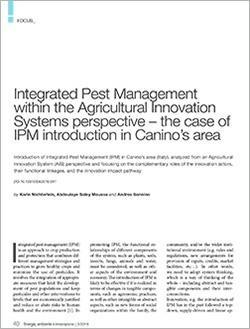
Integrated Pest Management within the Agricultural Innovation Systems perspective – the case of IPM introduction in Canino’s area
di Karin Nichterlein, Abdoulaye Saley Moussa, Andrea Sonnino
DOI 10.12910/EAI2016-041
Introduction of Integrated Pest Management (IPM) in Canino’s area (Italy), analyzed from an Agricultural Innovation System (AIS) perspective and focusing on the complementary roles of the innovation actors, their functional linkages, and the innovation impact pathway
Integrated pest management (IPM) is an approach to crop production and protection that combines different management strategies and practices to grow healthy crops and minimize the use of pesticides. It involves the integration of appropriate measures that limit the development of pest populations and keep pesticides and other interventions to levels that are economically justified and reduce or abate risks to human health and the environment. In promoting IPM, the functional relationships of different components of the system, such as plants, soils, insects, fungi, animals and water, must be considered, as well as other aspects of the environment and economy. The introduction of IPM is likely to be effective if it is realized in terms of changes in tangible components, such as agronomic practices, as well as other intangible or abstract aspects, such as new forms of social organizations within the family, the community, and/or the wider institutional environment (e.g. rules and regulations, new arrangements for provision of inputs, credits, market facilities, etc.). In other words, we need to adopt system thinking, which is a way of thinking of the whole – including abstract and tangible components and their interconnections. …

